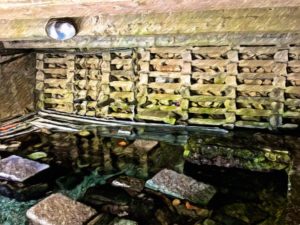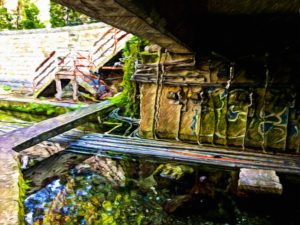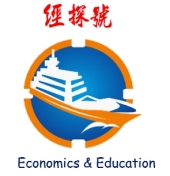Tamsui Spring Settlement
翻譯: 徐瑞儀

Datun foothill in North Taiwan has multiple springs, which became an important development resource in the early agricultural society in Tamsui. In the process of urbanization, agricultural society transformed into industrial society, the expansion of city streets had changed the way agricultural land was used. Lots of public water supplies also had changed in the process of urbanization, which not only the relationship between human and water but also the spatial form had changed essentially.
 Among these, Shui Xian To Spring is an important water source to Tamsui mountain suburb settlement. Before the days without modernized running water, the canals and streams that the springs flow into were also the main water source to the villagers’ daily life. In the agricultural period, the distribution of water resources was the prerequisite condition to agricultural economic production; therefore, the connection between agricultural water use and water resource organizations was really close. Due to the close connection, a self-managing water use system was formed among the villagers, making men the main workforce to face the collaborative and competitive water use relation. Women and children were mainly in charge of villagers’ livelihood water related labor. During the devolution of agriculture, rice stopped growing, and the village’s water resource organization started to collapse because of it. As the economic development and urban planning involved, housing development brought in new immigrants, built up a new community structure. In the meanwhile, the public water supplies were changed along with the transition of inhabitants. It became the local residents’ major space again for laundering, resting, etc. in their daily lives, which the concept of water use transformed into leisure water from livelihood water.
Among these, Shui Xian To Spring is an important water source to Tamsui mountain suburb settlement. Before the days without modernized running water, the canals and streams that the springs flow into were also the main water source to the villagers’ daily life. In the agricultural period, the distribution of water resources was the prerequisite condition to agricultural economic production; therefore, the connection between agricultural water use and water resource organizations was really close. Due to the close connection, a self-managing water use system was formed among the villagers, making men the main workforce to face the collaborative and competitive water use relation. Women and children were mainly in charge of villagers’ livelihood water related labor. During the devolution of agriculture, rice stopped growing, and the village’s water resource organization started to collapse because of it. As the economic development and urban planning involved, housing development brought in new immigrants, built up a new community structure. In the meanwhile, the public water supplies were changed along with the transition of inhabitants. It became the local residents’ major space again for laundering, resting, etc. in their daily lives, which the concept of water use transformed into leisure water from livelihood water.
Along with the development of Tamsui City, the public value for water has kept changing. Shuixiantou Spring has also changed its use-pattern as the time goes by, but continues to support the resident’s daily lives, which turns into a really unique local culture. The research shows that besides focusing on the influence of economic policies, the discussion of environmental water resources’ publicity should be focused on examining and discussing through the aspect of people’s life. After social activities, the decision-maker’s development point and user’s life point turn into water use space for the neighborhood after the interaction of conflict, coordination, and compromise.
